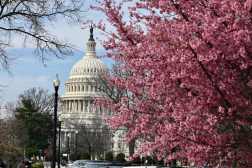Despite what many consider a very modest pay raise for government employees, the budget request for fiscal year 2015 appears to actually invest in the federal workforce.
Unveiled March 4, the FY 2015 budget request proposed a 1 percent pay increase for government employees, but emphasized more significant investments in training, development and recruitment initiatives for the federal workforce.
Beth Cobert, deputy director for management at the Office of Management and Budget, told reporters in call OMB will be launching pilot programs to look at recruiting and hiring processes to improve diversity and decrease skills gaps in the workforce.
In a White House news conference, OMB Director Sylvia Mathews Burwell said the administration is “pleased we can do the 1 percent increase” in pay for federal employees.
Burwell, Cobert and Steven VanRoekel, U.S. chief information officer, stressed it’s critical to have the right kind of talent in the federal government. VanRoekel cited the Presidential Innovation Fellows program as an example of how bringing external talent into government can make a great impact, in particular when that talent partners with federal agencies.
The talent aspect also plays into federal IT acquisition, and the enhancements the administration has acknowledged the process needs. Burwell said reforming how the government does IT procurement relies on improving the existing workforce, recruiting the “best and brightest” and attracting the best companies to work with.
IT spending takes a hit
The 2015 request for IT spending is down $2.3 billion from what was enacted in the 2014 fiscal year, slashed from $81.4 billion to $79.1 billion, VanRoekel said. The amount requested for civilian agencies remained nearly the same, while defense spending saw a $2.2 billion decrease.
Savings from shared services and strategic sourcing initiatives have helped decrease IT spend, VanRoekel said. He cited the PortfolioStat program — which has identified $1.6 billion in savings — and pointed also to the “dramatic consolidation of IT services throughout government.”
“We can no longer separate the effectiveness of federal programs from the smart use of IT,” VanRoekel said.
And that smart use of IT will include open data. Federal agencies will continue to unlock government data so entrepreneurs and innovators can leverage its potential, VanRoekel said. For example, the Commerce Department will invest to unleash economic statistical data in FY 2015, making it easier for entrepreneurs and innovators to use that information for public benefit.
According to VanRoekel and Cobert, the streamlining of commodities such as core administrative functions, human resources, IT and finance will improve the customer experience with government and cut costs.
VanRoekel listed a few examples of what can be expected in FY 2015:
- The Department of Veterans Affairs will modernize its IT systems to better manage and track veterans benefit deliveries;
- The Internal Revenue Service is working on its phone lines to have faster and more secure taxpayer interactions;
- Improved IT systems at the Social Security Administration will reduce wait times and enhance customer experience.
Open data and R&D
Cobert also laid out the president’s management agenda, which generally revolves around four key elements: effectiveness – delivering better, faster, smarter services to citizens and businesses; efficiency – increasing quality in value in the core operations and enhancing government productivity; economic growth – opening up federal data and the results of research and development to the private sector; people and culture – unlocking the full potential of today’s federal workforce.
The president’s budget request also proposed $135.4 billion be allocated toward federal research and development, an increase of 1.2 percent or $1.7 billion more than FY 2014-enacted levels. The budget calls for $69.5 billion for defense R&D, and $65.9 billion for nondefense R&D — both up from FY 2014.
There will be $2.9 billion for federal investments in science, technology, engineering and math education, a 3.7 percent increase over 2014 funding levels.
Several agencies received large amounts of budget funding for their R&D efforts:
- $30.2 billion for the National Institutes of Health
- $12.3 billion for the Energy Department
- $11.6 billion for NASA
- $7.3 billion for the National Science Foundation
- $2.4 billion for the Agriculture Department
- $1.2 billion for VA
Federal R&D programs such as the U.S. Global Change Research Program, the Networking and Information Technology Research and Development, and the National Nanotechnology Initiative all received at least $1.5 billion each.
“By continuing the administration’s record of steady support for research and development across the full spectrum of scientific and technological domains—including such diverse priorities as biomedicine, advanced manufacturing, climate science, cybersecurity, natural resource management, space exploration, and national security—the budget ensures that the United States will be an incubator of innovation and economic growth for many years to come,” said John Holdren, director of the Office of Science and Technology Policy and adviser to the president.




